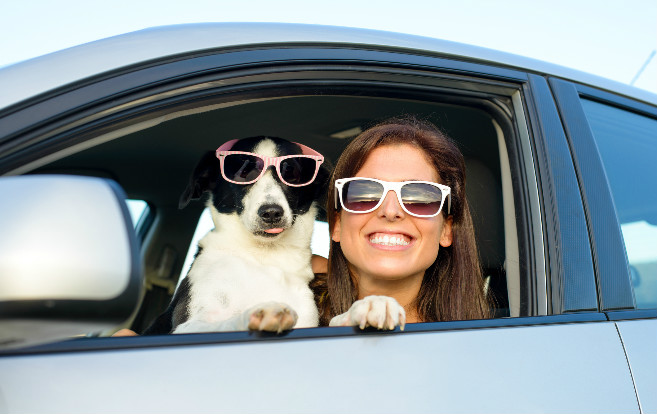Travel Nursing with Pets: How to Make It Work

Ready to try traveling with pets? What to do before, during and after your trip
By TravelNursing.com staff
One of the most frequently asked questions by prospective travel nurses is, “Can I take my pet on travel nursing assignments?”
The answer is "Yes," in most cases, but there are some restrictions in housing accommodations, and it can depend on the type of pet and breed.
RELATED: Dogs vs. Cats: Which Pets Make the Best Travel Companions?
Talk to your recruiter upfront about travel nursing with pets, and ask about pet-friendly accommodations. He or she can put you in touch with the agency’s housing specialists to review what’s available at a particular assignment, or you may decide to find a pet-friendly rental on your own.
Once you have made the decision to begin travel nursing with pets, there are a number of things you can do to make your journey together easier and help your best friend(s) settle in once you arrive.
Before you leave home:
• Update your pet’s vaccination records. Make sure your pet is current on all of his/her shots, and is sporting the rabies tag, if required. Bring shot records and important veterinary instructions with you.
• Ask your vet about medications for nervous or nauseous animals. If your pet gets motion sickness or shows signs of anxiety when traveling, talk to your vet about medicines that might help.
• Make sure your pet has a well-fitting collar with identification tags that include your cell phone number. And don’t forget to bring your pet’s leash.
• Consider microchipping your pet. The Humane Society of the United States (HSUS) reports that more than 10 million pets are lost each year, and only 1 in 10 will be recovered. Microchipping is one of the best ways to help you and your pet become reunited should it become lost. This simple procedure inserts a microchip the size of a grain of rice under your pet’s skin, between the shoulder blades; it feels similar to a shot, and the service is widely available at local humane societies and veterinary clinics.
• Pack all your pet’s medicines, beds, toys and other items that they will need to function well and feel at home in your new digs.
• Plan your route by finding pet-friendly hotels. If your trip will take you more than a full day by car, plan ahead to find appropriate accommodations; PetsWelcome.com can help you find the perfect place.
Traveling with pets by car
The majority of travel nurses will drive to their assignments, so it’s nice to know that the Humane Society of the United States strongly recommends traveling with pets by car over other methods of transportation. They also provide these tips to keep your pet safe:¹
• Don’t let animals roam in the car. For their safety as well as yours, dogs should be in crates and cats and other smaller animals should be in carriers, which are then anchored to the vehicle with a seatbelt or other secure means. Harnessing can keep pets from roaming, but it does not provide protection in case of accidents.
• Put pets in the back seat, to avoid the possibility of injury from deployed airbags.
• Keep heads inside; otherwise, pets may be hit by particles of debris or get sick from air forced into their lungs. Transporting animals in the back of a pickup truck is also a no-no.
• Allow plenty of rest stops. Make sure your four-legged friend has plenty of chances to exercise, eliminate and stay hydrated. And every time your pet exits the car with you, make sure he or she is in the carrier or on a leash, with ID tags.
• Don’t ever leave your pet alone in the car. Not only is there a chance that someone might try to take your precious pet, but temperatures inside a car can change quickly and pose a real danger. The HSUS reports that when its 72 degrees outside, with windows cracked, your car can reach temperatures of 116 in an hour; when it’s 85 degrees, it can reach 102 degrees in just 10 minutes and 120 degrees in 30 minutes--causing irreparable harm to animals.
• Share pet caretaking duties, if possible. It helps to share driving and pet caretaking duties with a friend or family member whenever possible.
¹ For more information and tips, read “Travel Safely with Your Pet by Car, Airplane, Ship, or Train” by the Humane Society of the United States.
At your assignment location
• Plan to arrive a few days early to let your pet get used to his/her new home, including you coming and going.
• Use furniture throws or slipcovers to avoid pet damage.
• Walk around your neighborhood and take the opportunity to meet other pet owners; you might even find a walking friend--for you and your pet.
• Find a nearby dog park or off-leash dog run on DogPark.com
• Find a pet sitter or dog walker near you, if needed, using local searches or national resource sites like Care.com, The National Association of Professional Pet Sitters (PetSitters.org) and Rover.com.
Seize the opportunity to try travel nursing with pets, friends or family--or just on your own. Advance your career with excellent pay in thousands of locations; apply now to travel!
© 2015. AMN Healthcare, Inc. All Rights Reserved.